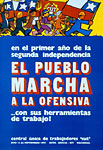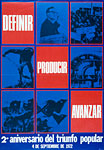Chile 1970-1973
On September 4, 1970 Salvador Allende won the presidential elections in Chile. This political event started a unique experiment in Latin America, an experiment that generated much interest in the world and led to the involvement of many solidarity movements in the Third World. The three years of Allende's rule, together with the parties of the Unidad Popular (UP), were years of increasing tensions and fierce polarization, ultimately leading to the coup d'etat of September 11, 1973.
Chile was a relatively developed country in Latin America, a country with an established democracy and an army that abided by a legal and constitutional tradition. Of course there were economic and social problems. There were large landed estates and a considerable number of landless poor farm laborers. Industry was expanding, but exports were dominated by a single product: copper, mined by two large American companies. The middle classes, a heterogeneous group composed of various professions and comprising different functions, were strongly dependent on the state.
Even prior to the Allende presidency, the Christian Democratic president (DC) Frei, had initiated land reforms. After Allende came to power (who was elected on September 4, 1970 with the support of the DC), this policy was continued. But under Allende the aims changed. The Unidad Popular, though peaceful and democratic, was committed to bringing socialism to Chile. In the Unidad Popular the PC (communists), PS (socialists), PR (social democrats), and the radical Christian parties, MAPU and IC worked together. Outside parliament the revolutionary zeal was fanned by the MIR (Movimiento de Izquierda Revolucionaria).
For the right wing parties this constellation proved sufficient to bring about the failure of Allende's policies. The presence of the Partido Comunista in itself was enough to trouble the USA, let alone the nationalization of the American copper firms Anaconda and Kennecott in July 1971. This caused outright hostility in the US government to the UP project. The sabotage campaigns in Washington were intensified.
From the beginning the UP government's repeated problems intensified over the course of its three years. The government was exclusively oriented toward the workers, which fed the mistrust of the middle classes. The government's actions were a consequence of their programme, the dynamics emerging after September 1970, and the divisions within the UP coalition. While some measures went too far for the communists, for parts of the PS and the MIR they did not go far enough. It should also be remembered that the UP never had a majority in parliament.
Wages were raised, (those at the bottom of the scale more then the higher ones), schoolchildren were given half a liter of milk per day, and the land reforms were continued. When landless laborers wanted to speed up this process they occupied the land. The UP government used a legal measure from the short-lived Socialist Republic of 1932, to take over companies. This law provided a legal basis to intervene in companies where there were conflicts or where owners sabotaged production. If the workers thought this was the case, they struck or occupied the company, thus provoking government intervention. At the end Allende's government nationalized 40% of the industry.
The first year the problems were relatively mild. In 1972 the situation deteriorated rapidly. This was a result of the cessation of aid from the Nixon government and institutions like the World Bank. Also, the price of copper fell sharply. The American boycott of tools and machinery needed for the Chilean industry was also felt. But perhaps even more important was the feeling of scarcity and the perceived threat to the middle classes.
In December 1971 there occurred the first demonstration by middle class women with pots and pans against the supposed scarcity. From that moment on the right gained the initiative. The leftist coalition became bogged down in discussions whether to proceed step by step towards socialism or to establish socialism in the present by concrete acts, such as occupations of factories and land. In 1972 Chile was in real trouble: inflation reached 70%. Independent truckers went on strike in October, followed by shopkeepers and small manufacturers. The DC of Aylwin completely broke with the UP. There were increasing calls for military intervention.
While the elections of March 1973 were won by the UP, they did not gain a decisive majority. Conflicts raged in the streets. Within the leftist community the debates now centered on the question whether to arm the workers in the occupied factories and people's committees. On the 29th of June 1973 an army unit attacked the presidential palace. Commander Prats crushed this rising, but tensions mounted.
On August 22, 1973 the House of Representatives voted in favor of a motion that declared the government unconstitutional. This removed the last legal and constitutional objections of most of the military to a coup d'etat, and Prats was forced to resign.
In these confused days Allende decided to put his policies before the people of Chile in a referendum, to be held on September 11. The newly appointed commander in chief of the Army, Augusto Pinochet, then accelerated existing plans for intervention.


